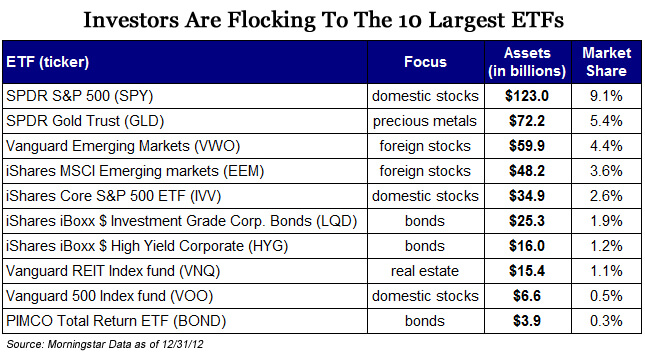Forget Mutual Funds — Try This Simple, Low-Cost Alternative Instead
As the stock market surged ever higher in the 1990s, many investors were content to let mutual fund managers find the right stocks for them. After all, the nation’s leading mutual funds were racking up stellar gains, and it was of little concern that investors had to pay 1% to 3% in annual fees for the high-priced salaries paid out to many fund managers.
But in the next decade, parking your money in a mutual fund no longer seemed such a wise move — many of the most popular funds failed to even keep up with their benchmarks (such as the S&P 500 or the Nasdaq Composite Index). Add to that the funds tacked on onerous management fees.#-ad_banner-#
Investors have had enough, and they have been pulling out of mutual funds steadily in the past five years. In fact, with $11.6 trillion in mutual fund assets at the end of 2011, investors took more than $125 billion out of stock-focused mutual funds in 2012, according to the Investment Company Institute (ICI).
Where’s that money going? Exchange-traded funds (ETFs), which trade on the major stock exchanges with their own ticker symbols.
These funds, which first appeared roughly 20 years ago, allow you to target specific investment angles such as gold, energy and even foreign countries. Yet they do so without the active hand of a high-priced fund manager. Instead, ETFs are generally “passive,” which means they own a select group of stocks (or bonds) and then hold them for a very long time. That means lower trading costs and very little management overhead, which adds up to much lower annual expenses.
For example, the Fidelity Advisor Large Cap B fund charges 2.04% in annual expenses. The fund owns a range of blue chip stocks such as Apple (Nasdaq: AAPL), JP Morgan (NYSE: JPM) and Chevron (NYSE: CVX). In contrast, the SPDR S&P 500 ETF (NYSE: SPY) owns a very similar basket of stocks and charges just 0.09% in annual expenses. In effect, that Fidelity fund would have to generate annual returns of at least 2% just to deliver the same net-of-fees result as the ETF.
ETFs had their first breakout year in 2008, when investors poured $169 billion into them. Most of the money went straight into ETFs that owned U.S. stocks. Fast-forward to 2012, and times have surely changed. ETFs received a record $191 billion last year, though the bulk of that money was earmarked for bond ETFs, international stocks and sector-focused funds. In fact, the amount of money tied up in ETFs now exceeds $1.35 trillion, more than double the amount seen at the end of 2008.
It should come as no surprise that Vanguard, which was known for very low expense loads in mutual funds, has sought to become a leading player in ETFs. Indeed Vanguard is now the industry’s third-largest in terms of stock-and-bond ETF assets under management, well ahead of traditional retirement fund firms such as Fidelity and T. Rowe Price.
Barclays’ group of iShares funds remains the top dog, with roughly 40% market share, while State Street Global Advisors, with its pioneering SPDRs program, controls roughly one-quarter of the market. In effect, Barclays, State Street and Vanguard now control more than 80% of this market. Smaller rivals such as Wisdom Tree, Van Eck, PIMCO and Invesco’s PowerShares division continue to try to take market share from the bigger players in 2013 with offerings.

Where’s the action right now? Well, the top three most popular funds in 2012 (in terms of new assets gathered) were the Vanguard Emerging Markets (NYSE: VWO), the iShares iBoxx $ Investment Grade Corp. Bonds (NYSE: LQD) and the iShares MSCI Emerging Markets (NYSE: EEM).
These funds are heavily traded, which means the gap between the price you would pay to buy them and the price you would receive when you sell them (known as the bid/ask spread) is narrow, usually just a penny. Conversely, there are now hundreds of smaller ETFs that don’t see as much interest and as a result often sport wider bid/ask spreads that can eat into your profits. As a good rule of thumb, focus on ETFs that trade at least 100,000 shares daily.
Action to Take –> As ETFs rise in popularity, the number of ETFs available has risen from 113 a decade ago to more than 1,200 today. The key is to identify the specific parts of the domestic or global economy you would like to target, then find out which ETFs are available to meet them. If you find multiple ETFs that appear to match an identical topic, then focus on the ETF that has the lowest expense ratio and the highest daily trading volume.
This article originally appeared on InvestingAnswers.com:
Forget Mutual Funds — Try This Simple, Low-Cost Alternative Instead
P.S. — If you’re looking for a smarter, safer, and more profitable approach to income investing than you may be following now, then you need to know about Retirement Savings Stocks. Simply put, if you’re looking for a second income stream for your retirement, then it’s the only way to go. Find out more in this special presentation.
